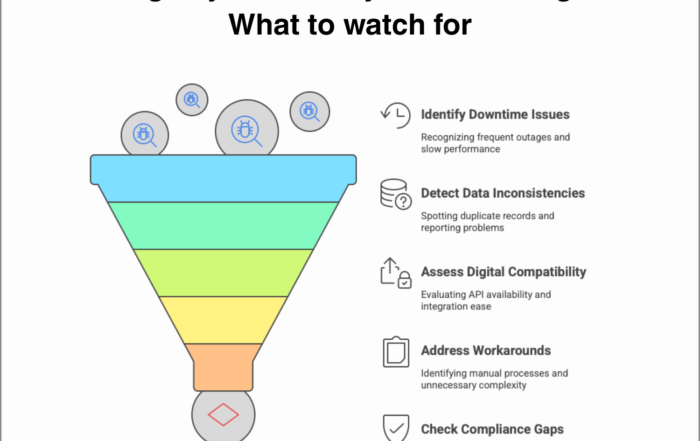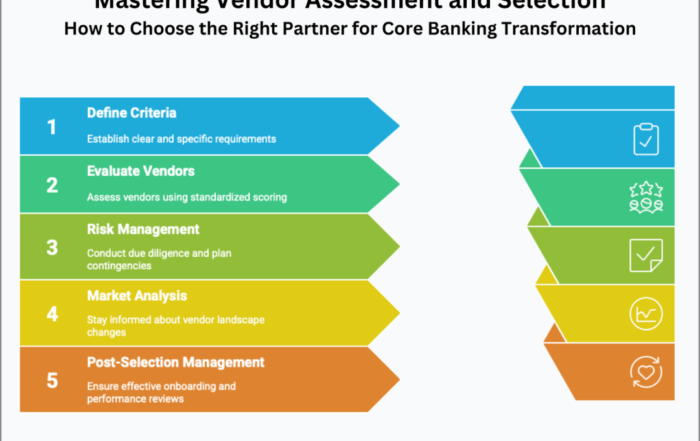
Is your core system holding you back? The OptimizeCore® Scorecard helps you evaluate whether optimization or replacement is the smarter choice, based on real data, not assumptions.
The Hidden Costs of “Good Enough”
In banking, “if it ain’t broke, don’t fix it” can be an expensive mistake—especially when it comes to your core system.
The truth? Core failures rarely show up as dramatic crashes. More often, they creep in quietly—through sluggish performance, clunky workarounds, and a growing pile of compliance headaches. And by the time those cracks become visible, the real damage is already done.
If any of the warning signs below feel familiar, it’s time to ask a critical question:
Can your core be optimized—or is replacement inevitable?
That’s exactly what the OptimizeCore® Scorecard is designed to help you figure out.
1. Frequent Downtime & Performance Issues
What to Watch For:
- Transactions are slower than expected—or fail without warning
- Outages are becoming more common—and more disruptive
- IT is constantly in “firefighting mode”, patching instead of improving
- The system lags under peak volumes, frustrating staff and customers alike
Real-World Story:
A mid-sized bank dealt with monthly outages that triggered spikes in customer complaints. Turns out, it wasn’t the core itself—it was misconfigured infrastructure and neglected system tuning. No replacement required.
What to Do:
Before jumping to conclusions, run a Core System Health Check. Many performance problems come down to misconfigurations, outdated architecture, or inefficient usage—all of which can be fixed without a full system overhaul.
2. Data Inconsistencies & Reporting Nightmares
What to Watch For:
- Duplicate or incomplete customer records
- Financial reports that need manual patching to make sense
- Compliance audits that turn into multi-week fire drills
- Spreadsheets—everywhere—because the core reporting tools don’t cut it
Real-World Story:
One commercial bank couldn’t segment customers properly because staff were stuffing notes into address fields rather than using the system’s built-in data fields. The problem wasn’t tech—it was training and process.
What to Do:
Most “bad data” issues start with bad inputs, not bad systems. Standardize how teams enter data, clean up your structures, and make sure staff actually know how to use the tools you already have.
3. Your Core Can’t Keep Up with Digital or Fintech
What to Watch For:
- Your core lacks open APIs—making partnerships and integrations a slog
- Digital features take months (or years) to roll out
- You’re using costly middleware to glue together legacy and modern tools
- Your innovation pipeline is constantly delayed by system limitations
Real-World Story:
A bank tried to launch a Buy Now, Pay Later (BNPL) offering—but their core had no native API support. The workaround? A six-figure custom integration that took six months and nearly derailed the product.
What to Do:
A rigid core doesn’t always mean it’s time to replace. Start by exploring modular enhancements, cloud-based add-ons, and integration hubs that can extend your capabilities without blowing up your infrastructure.
4. Workarounds Are Becoming the Norm
What to Watch For:
- Teams manually track compliance issues like escheatable accounts
- Spreadsheets replace basic system reporting
- Customer service reps are re-entering data across multiple screens
- IT gets pulled in for routine system changes
Real-World Story:
A regional bank was manually tracking dormant accounts for escheatment—completely unaware that their core system already had the feature built in. The result? Extra work, higher risk, and unnecessary complexity.
What to Do:
Run a Process Readiness Assessment. Odds are, you’re sitting on unused functionality, overlooked features, or poor configuration. Start there before making the case for replacement.
5. Compliance & Security Gaps Are Mounting
What to Watch For:
- Meeting new regulatory requirements feels like reinventing the wheel
- Your core has unpatched security vulnerabilities
- Audit logs are incomplete or inconsistent
- You’ve received warnings or fines tied to process gaps
Real-World Story:
One institution failed a KYC audit because its system lacked automated customer due diligence workflows. But here’s the twist: those workflows could have been added via a vendor-supported upgrade.
What to Do:
Ask whether your core is still receiving updates and vendor support. Many compliance and security gaps can be closed through configuration, training, and targeted upgrades—no rip-and-replace necessary.
What’s Next: Optimize or Replace?
If any of these red flags sound familiar, don’t panic—and definitely don’t default to a full system replacement.
What you need is a clear, structured way to evaluate where your core stands, where it’s failing you, and what to do about it. That’s exactly what the OptimizeCore® Scorecard helps you do.
Ready to make a smarter call?
Take the OptimizeCore® Scorecard and get a custom assessment of your core system’s health, risks, and best next step—whether that’s optimization, modular upgrades, or a phased replacement.
#CoreBankingTransformation #CoreBankingOptimization




